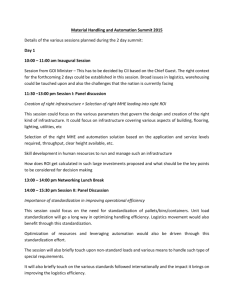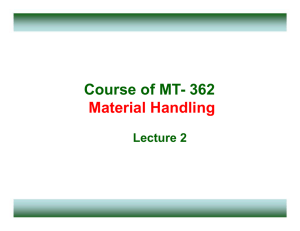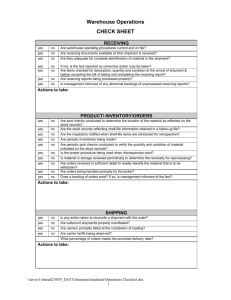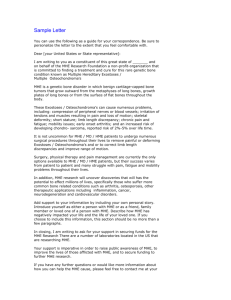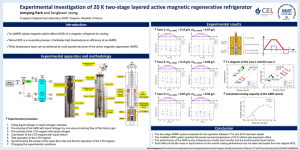USING MATERIALS-HANDLING EQUIPMENT FM 10-15 CHAPTER 11 DETERMINING RESPONSIBILITIES
advertisement
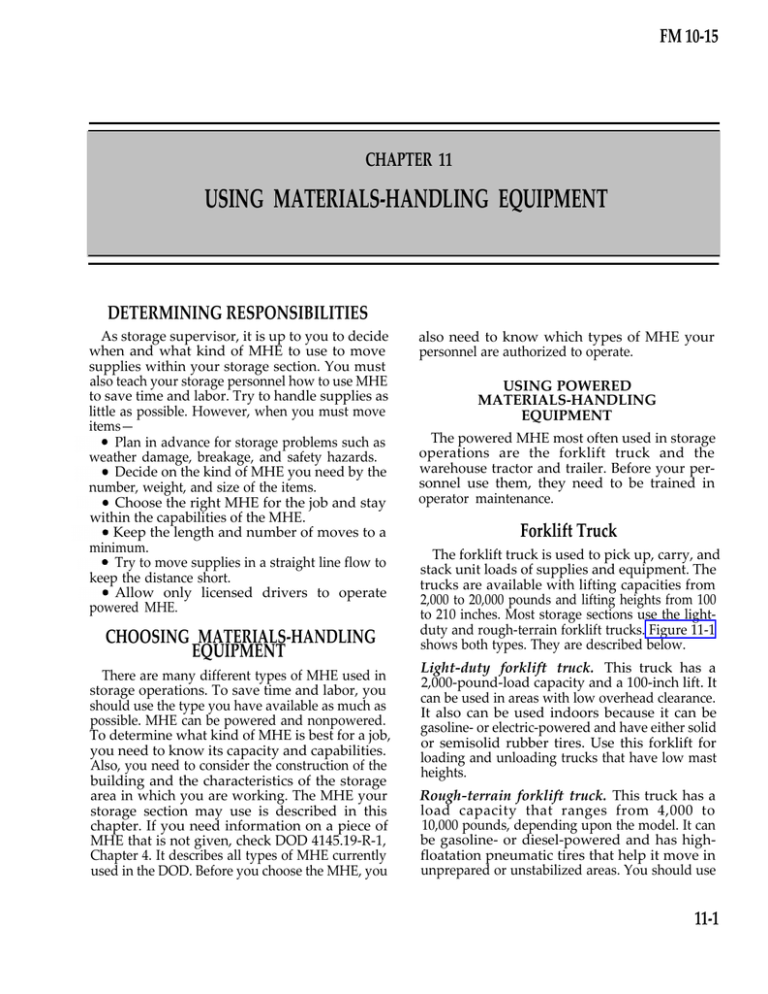
FM 10-15 CHAPTER 11 USING MATERIALS-HANDLING EQUIPMENT DETERMINING RESPONSIBILITIES As storage supervisor, it is up to you to decide when and what kind of MHE to use to move supplies within your storage section. You must also teach your storage personnel how to use MHE to save time and labor. Try to handle supplies as little as possible. However, when you must move items— Plan in advance for storage problems such as weather damage, breakage, and safety hazards. Decide on the kind of MHE you need by the number, weight, and size of the items. Choose the right MHE for the job and stay within the capabilities of the MHE. Keep the length and number of moves to a minimum. Try to move supplies in a straight line flow to keep the distance short. Allow only licensed drivers to operate powered MHE. CHOOSING MATERIALS-HANDLING EQUIPMENT There are many different types of MHE used in storage operations. To save time and labor, you should use the type you have available as much as possible. MHE can be powered and nonpowered. To determine what kind of MHE is best for a job, you need to know its capacity and capabilities. Also, you need to consider the construction of the building and the characteristics of the storage area in which you are working. The MHE your storage section may use is described in this chapter. If you need information on a piece of MHE that is not given, check DOD 4145.19-R-1, Chapter 4. It describes all types of MHE currently used in the DOD. Before you choose the MHE, you also need to know which types of MHE your personnel are authorized to operate. USING POWERED MATERIALS-HANDLING EQUIPMENT The powered MHE most often used in storage operations are the forklift truck and the warehouse tractor and trailer. Before your personnel use them, they need to be trained in operator maintenance. Forklift Truck The forklift truck is used to pick up, carry, and stack unit loads of supplies and equipment. The trucks are available with lifting capacities from 2,000 to 20,000 pounds and lifting heights from 100 to 210 inches. Most storage sections use the lightduty and rough-terrain forklift trucks. Figure 11-1 shows both types. They are described below. Light-duty forklift truck. This truck has a 2,000-pound-load capacity and a 100-inch lift. It can be used in areas with low overhead clearance. It also can be used indoors because it can be gasoline- or electric-powered and have either solid or semisolid rubber tires. Use this forklift for loading and unloading trucks that have low mast heights. Rough-terrain forklift truck. This truck has a load capacity that ranges from 4,000 to 10,000 pounds, depending upon the model. It can be gasoline- or diesel-powered and has highfloatation pneumatic tires that help it move in unprepared or unstabilized areas. You should use 11-1 FM 10-15 this forklift in field areas. Use it mainly for loading and unloading flatbed semitrailers and for stacking large, heavy loads. Warehouse Tractor and Trailer A warehouse tractor is a gasoline- or electricpowered vehicle used to pull one or more warehouse trailers. The tractor has a drawbar pull ranging from 2,000 to 7,500 pounds and has either solid rubber or pneumatic tires. The warehouse trailer is platform-mounted on wheels. It is used to carry loads of various sizes. You can hook two or more trailers together to form a train when you need to move a large number of supplies. The warehouse tractors and trailers most often used in storage sections are shown in Figure 11-2. They are described below. 11-2 Light-duty warehouse tractor. The lightduty, electric-powered warehouse tractor has a 2,000-pound drawbar pull and solid rubber tires. It can be used in closed warehouses. Since it emits no fumes, it also can be used to transport food items. You should use this tractor for light loads in warehouses and in cold-storage areas since varying temperatures do not affect its performance. Medium-duty warehouse tractor. T h i s gasoline-powered tractor has a 4,000-pound drawbar pull and pneumatic tires. It can be used in outdoor storage areas for general-purpose towing. It has enough horsepower and traction to operate on all types of surfaces. W a r e h o u s e t r a i l e r . The trailer used with a warehouse tractor is a load-carrying platform on FM 10-15 pneumatic tires. The normal capacities for a trailer used in storage areas range from 6,000 to 20,000 pounds. Because the rear wheels of the heavy-duty trailer are mounted on a rigid axle that carries about two-thirds of the load, it can be used for oversized loads and rough surfaces. You should use the light-duty trailer for indoors storage operations. USING NONPOWERED MATERIALS-HANDLING EQUIPMENT Your personnel should use nonpowered MHE for all operations that do not require powered MHE. You should also remind them to use nonpowered MHE if it is more economical, even though it may take a little more effort. Figure 11-3 shows the conveyors and Figure 11-4 shows the hand-lift trucks, platform trucks, and other nonpowered MHE most often used in storage sections. Conveyors Conveyors are used to move supplies in a fixed line of travel. They are used mainly for loading and unloading trucks and railroad cars. The three major kinds used in most storage operations are gravity roller, roller, and skatewheel conveyors. The skatewheel conveyor is probably used most often because it is lightweight, easy to setup, and easily transported. Be sure that you and your personnel know the weight limits of each type of conveyor before anyone places heavy supplies on it. 11-3 FM 10-15 Hand-lift Truck This truck is sometimes called a pallet jack or hydraulic jack. It has two load-carrying tracks that can be raised about 4 inches to carry pallet loads. Use it to move pallet loads that do not have to be stacked and to move loads short distances. It can be operated in small spaces where forklifts cannot fit. storage personnel use to reach the higher shelves. You should use the two-wheeled truck for moving cartons, cases, bags, and barrels short distances. Use the four-wheeled hand truck in stocking and packing areas. Platform Truck The MHE your storage section uses is probably controlled by a central office. When you need a piece of MHE, contact the personnel in this office and they will dispatch it to you. When you finish a job, you must return the MHE to the central office. If you need MHE for longer periods of time, such as for maneuvers or special operations, you must contact the central office for a special dispatch. Since not all DSUs use these controls, you should check with your accountable officer to find out what procedures your DSU follows. This truck is used mainly for moving short distances with frequent stops. It is used also in close areas since it is easy to maneuver in areas with limited space. The two basic types of platform trucks are the two-wheeled, which is called a dolly, and the four-wheeled, which is known as a hand truck. Some warehouses also use a stockpicker truck to move large quantities of small items at one time. It has a built-in stepladder that 11-4 CONTROLLING MATERIALS-HANDLING EQUIPMENT FM 10-15 11-5 FM 10-15 MAINTAINING MATERIALS-HANDLING EQUIPMENT You and your personnel must keep the MHE under your care in good working order. The MHE operators must make the checks, perform all the services needed, and report any problems or deficiencies promptly. If your storage section is assigned MHE on a regular basis, you must work with the maintenance activity to schedule the MHE for maintenance checks and repairs. If the maintenance activity that supports your DSU is located a distance away, you can sometimes request a contact team to come to your storage section to perform maintenance. Teach your personnel that MHE is only as good as the care it receives, Make sure that they use the correct operator’s manuals as a guide when they perform minor maintenance. NOTE: PS Magazine articles give helpful tips on maintaining your MHE. They also give telephone numbers that you can call for information and assistance. You should file these magazines where your personnel can find them. The January issue 11-6 (beginning in 1981) contains an index of all items and problems discussed in articles during the previous year. Before 1981, a separate index was printed each year. To get back issues of PS Magazine, contact: Editor PS Magazine c/o US Army Materiel Readiness Support Activity Lexington, KY 40511-5101 As storage supervisor, you must make sure your MHE operators are trained and licensed. Only licensed operators can drive and operate the powered MHE. You should keep a list of those in your DSU who have MHE licenses. You may need to contact them in an emergency. All powered MHE that your personnel use must have a fully charged fire extinguisher. Make sure your personnel know and follow the safety guidelines for MHE operation. These guidelines are listed in each MHE operator’s manual.
